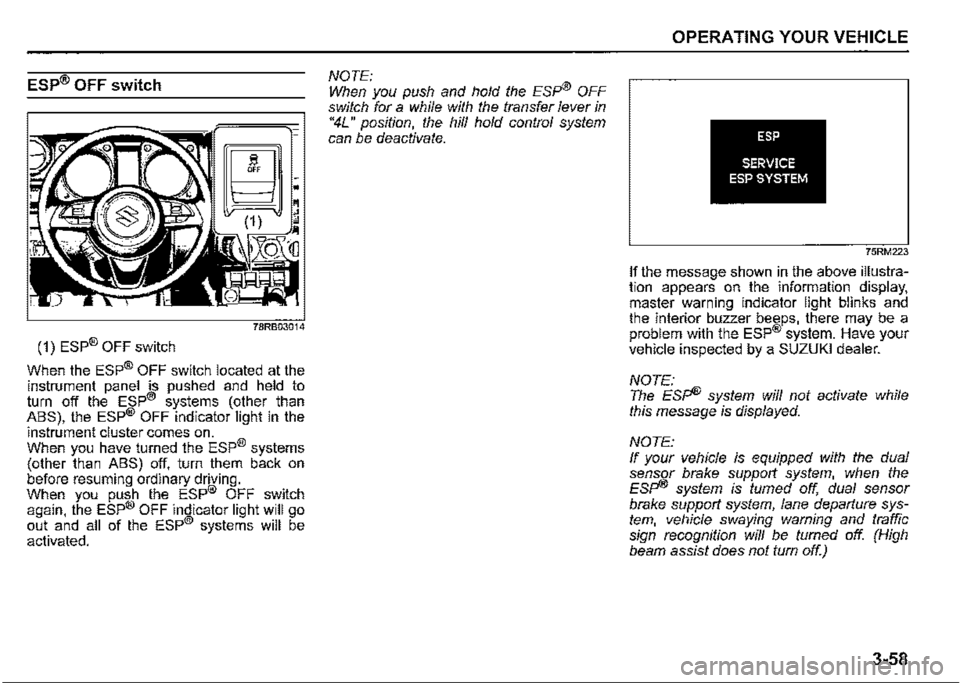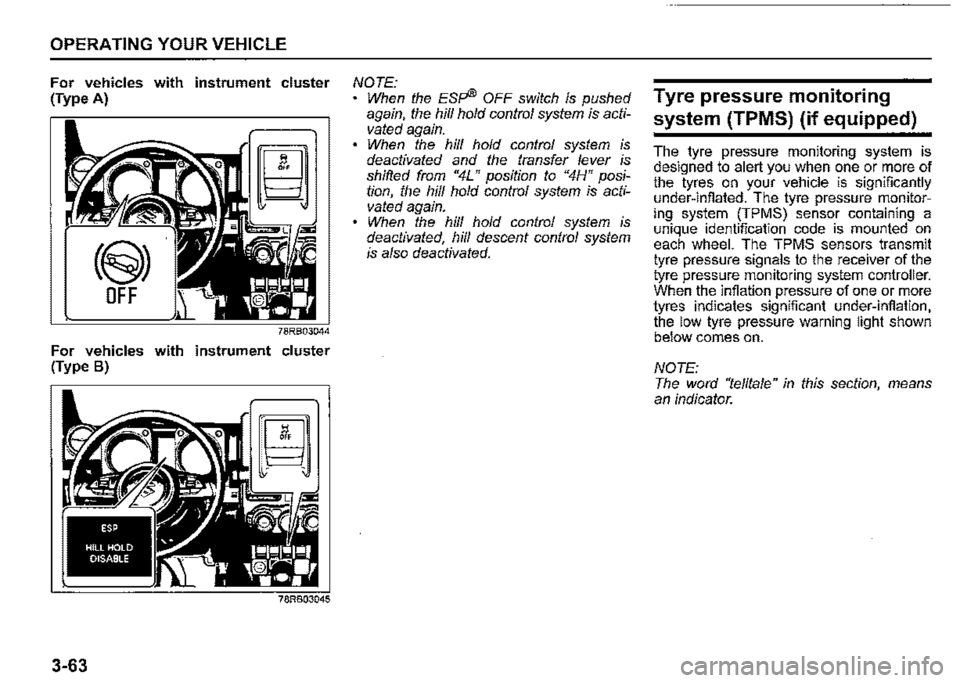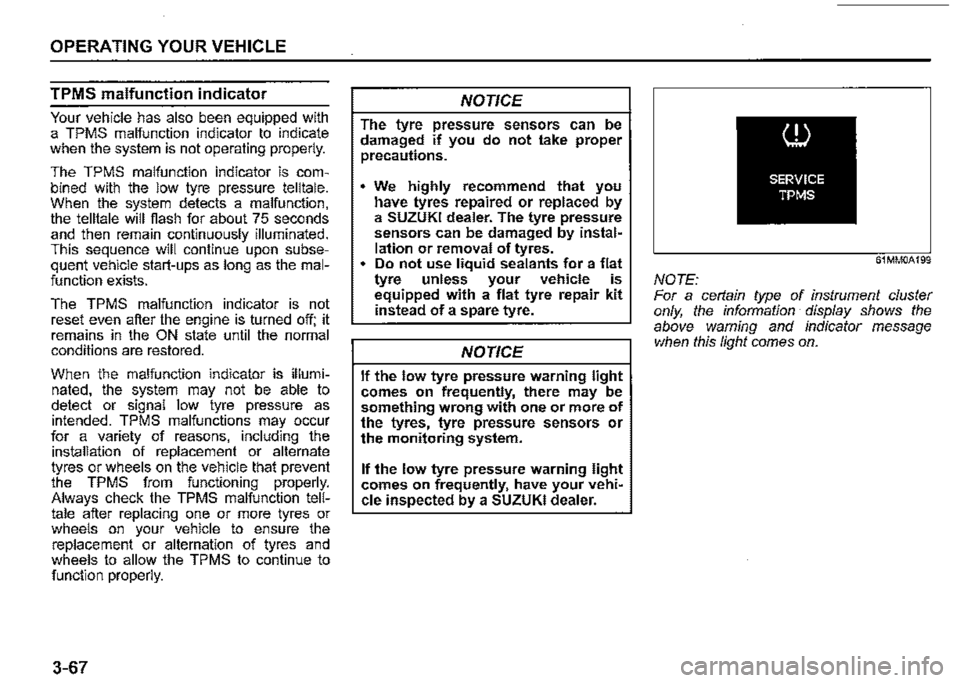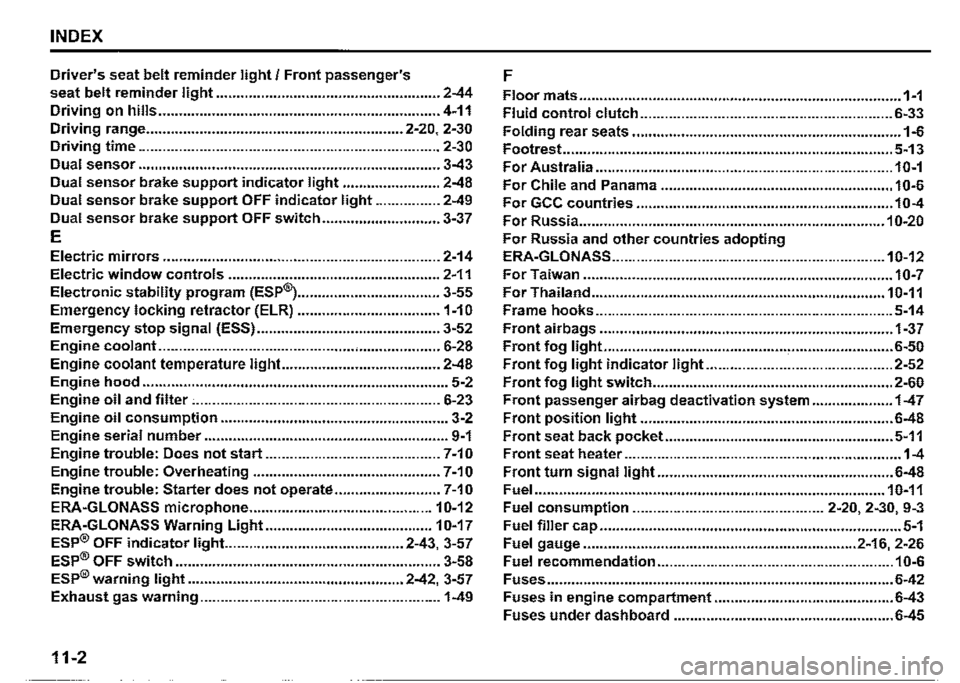light sensor SUZUKI JIMNY 2021 Owner's Guide
[x] Cancel search | Manufacturer: SUZUKI, Model Year: 2021, Model line: JIMNY, Model: SUZUKI JIMNY 2021Pages: 421, PDF Size: 6.35 MB
Page 201 of 421

72M20405
When your vehicle is weighed down by heavy items in the luggage compartment or rear seat When wheel alignment is deviated When the tyres are not infiated to the recommended tyre pressure or the tyres are worn With snow chains or non-specified sized tyres equipped When you have a temporarily repaired fiat tyre With a modified suspension equipped When passing through the entrance or exit of the tunnel and the brightness is changed extremely When driving without lighting the headlights at night or in tunnels When driving on the following roads -On sharp curves or extremely rough surfaces -On a steep slope -On seam of the road When vehicle is swaying When the optical axis of the headlight is deviated
With modified headlights and/or front fog lights equipped When the headlights are covered in dirt, snow, ice or mud
When the following types of a vehicle are in front of you, or when the following situations occur, the dual sensor may not detect a vehicle in front of you or may need more time to detect a vehicle. ·
72M20407
Vehicles in front of you have small, low, or uneven backs as shown below: -A track without side or back gates, and when mounting no luggage on the cargo bed -A vehicle with luggage protruding out from the back -A specially shaped vehicle such as a car carrier trailer or a motorcycle with side car -A low-slung vehicle When ground clearance of vehicle in front of you is extremely high. When a vehicle is oncoming or retreating vehicle
OPERATING YOUR VEHICLE
When a vehicle facing sideways When a vehicle in front of you without turning on the tail lights at night or in tunnels When a vehicle in front of you refiects sunlight strongly When there is a wall in front of the parked vehicle When there is another obstacle beside a vehicle
D
72M20406
When only a part of the vehicle in front of you is within the dual sensor detection field When the difference of speed between the vehicle in front of you and your vehicle is increased When the distance to the vehicle in front of you is short When the vehicle in front of you is difficult to refiect the laser beam When driving on a curve For a while after escaping from a curve When the vehicle in front of you turns, accelerates or decelerates suddenly When a vehicle in front of you jumps out
3-50
Page 202 of 421

OPERATING YOUR VEHICLE
• When you change the lane and approach the leading vehicle
When the following types of partition lines are in front of you, or when the following situations occur, the dual sensor may not detect the lines or may need more time to detect the lines. • The narrow lane width • When the lane is difficult to detect -No partition lines, or faded lines -The color of partition lines is similar to the road -The width of partition lines is narrow -The partition lines has blurred -There are road studs or stones -The partition lines can not be seen, or difficult to see due to sand, etc. -Driving on a road that is wet due to rain, after the rain, puddles, etc. -The partition lines drew on a curb -Driving on a road that is bright due to reflected light, etc. When the distance to the vehicle in front of you is short Immediately after the lane change, or immediately after passing through the intersection.
3-51
Page 209 of 421

ESP® OFF switch
(1) ESP® OFF switch
When the ESP® OFF switch located at the instrument panel is pushed and held to turn off the ESP® systems (other than ABS), the ESP® OFF indicator light in the
instrument cluster comes on. When you have turned the ESP® systems (other than ABS) off, turn them back on before resuming ordinary driving. When you push the ESP® OFF switch again, the ESP® OFF indicator light will go out and all of the ESP® systems will be activated.
NOTE: When you push and hold the Esp® OFF switch for a while with the transfer lever in "4L" position, the hill hold control system can be deactivate.
OPERATING YOUR VEHICLE
ESP
SERVICE ESP SYSTEM
75RM223
If the message shown in the above illustration appears on the information display, master warning indicator light blinks and the interior buzzer beeps, there may be a problem with the ESP® system. Have your vehicle inspected by a SUZUKI dealer.
NOTE: The Esp® system will not activate while this message is displayed.
NOTE: If your vehicle is equipped with the dual sensor brake support system, when the Esp® system is turned off, dual sensor brake support system, lane departure system, vehicle swaying warning and traffic sign recognition will be fumed off. (High beam assist does not turn off.)
3-58
Page 214 of 421

OPERATING YOUR VEHICLE
For vehicles with instrument cluster (Type A)
For vehicles with instrument cluster (Type B)
78RB03045
3-63
NOTE: • When the ESffe OFF switch is pushed again, the hill hold control system is activated again. When the hill hold control system is deactivated and the transfer lever is shifted from "4L" position to "4H" position, the hill hold control system is activated again. When the hill hold control system is deactivated, hill descent control system is also deactivated.
Tyre pressure monitoring
system (TPMS) (if equipped)
The tyre pressure monitoring system is designed to alert you when one or more of the tyres on your vehicle is significantly under-inflated. The tyre pressure monitoring system (TPMS) senso_r containing a unique identification code 1s mounted on each wheel. The TPMS sensors transmit tyre pressure signals to the receiver of the tyre pressure monitoring system controller. When the inflation pressure of one or more tyres indicates significant under-inflation, the low tyre pressure warning light shown below comes on.
NOTE: The word "telltale" in this section, means an indicator.
Page 218 of 421

OPERATING YOUR VEHICLE
TPMS malfunction indicator
Your vehicle has also been equipped with a TPMS malfunction indicator to indicate when the system is not operating properly.
The TPMS malfunction indicator is combined with the low tyre pressure telltale. When the system detects a malfunction, the telltale will flash for about 75 seconds and then remain continuously illuminated. This sequence will continue upon subsequent vehicle start-ups as long as the malfunction exists.
The TPMS malfunction indicator is not reset even after the engine is turned off; it remains in the ON state until the normal conditions are restored.
When the malfunction indicator is illuminated, the system may not be able to detect or signal low tyre pressure as intended. TPMS malfunctions may occur for a variety of reasons, including the installation of replacement or alternate tyres or wheels on the vehicle that prevent the TPMS from functioning properly. Always check the TPMS malfunction telltale after replacing one or more tyres or wheels on your vehicle to ensure the replacement or alternation of tyres and wheels to allow the TPMS to continue to function properly.
3-67
NOTICE
The tyre pressure sensors can be damaged if you do not take proper precautions.
We highly recommend that you have tyres repaired or replaced by a SUZUKI dealer. The tyre pressure sensors can be damaged by installation or removal of tyres. • Do not use liquid sealants for a flat tyre unless your vehicle is equipped with a flat tyre repair kit instead of a spare tyre.
NOTICE
If the low tyre pressure warning light comes on frequently, there may be something wrong with one or more of the tyres, tyre pressure sensors or the monitoring system.
If the low tyre pressure warning light comes on frequently, have your vehi~ cle inspected by a SUZUKI dealer.
61MM0A199
NOTE: For a cerlain type of instrument cluster only, the information display shows the above warning and indicator message when this light comes on.
Page 219 of 421

TPMS limitations
The tyre pressure monitoring system may not function properly under certain circumstances. In the following situations, the low tyre pressure warning light may come on and remain on or may blink. When you replace a flat tyre with the spare tyre. When you include a spare tyre during a tyre rotation. When the TPMS sensor is damaged during a tyre replacement or liquid sealants are used to repair a flat tyre. When the electronic signal of TPMS sensor is disturbed in one of the following ways: -Electric devices or facilities using similar radio wave frequencies are nearby. -A metallic film that may cause radio wave interference is attached on the window. -A lot of snow or ice covers the vehicle, in particular, around the wheels or wheel housings. -Snow tyres that are not installed with genuine TPMS sensors or snow chains are used.
When you use non-genuine SUZUKI wheels or tyres. When the pressure of any tyre is too high. When there is a problem with the receiver of the TPMS controller.
TPMS setting (For instrument cluster -Type A)
You can set one of the initial value of tyre pressure below that is indicated on the tyre information label. -Comfort Mode -Load Mode
For details on how to set the mode, refer to "Setting mode" in "BEFORE DRIVING" section.
A WARNING
If the loading weight has changed, adjust the tyre pressure according to the tyre information label and set the initial value via the information display. If the loading weight, tyre pressure and initial value do not match, the tyre pressure monitoring system will not function properly.
OPERATING YOUR VEHICLE
TPMS setting (For instrument clus
ter• Type B)
• You can check the current tyre pressure on the information display. • You can set one of the initial value of tyre pressure below that is indicated on the tyre information label. -Comfort Mode
-Load Mode
A WARNING
If the loading weight has changed, adjust the tyre pressure according to the tyre information label and set the initial value via the information display. If the loading weight, tyre pressure and initial value do not nJatch, the tyre pressure monitoring system will not function properly.
3-68
Page 412 of 421

INDEX
Driver's seat belt reminder light/ Front passenger's F seat belt reminder light ....................................................... 2-44 Floor mats ............................................................................... 1-1 Driving on hills ..................................................................... 4-11 Fluid control clutch .............................................................. 6-33 Driving range ............................................................... 2-20, 2-30 Folding rear seats .................................................................. 1-6 Driving time .......................................................................... 2-30 Footrest ................................................................................. 5-13 Dual sensor .......................................................................... 3-43 For Australia ......................................................................... 10-1 Dual sensor brake support indicator light ........................ 2-48 For Chile and Panama ......................................................... 10-6 Dual sensor brake support OFF indicator light ................ 2-49 For GCC countries ............................................................... 10-4 Dual sensor brake support OFF switch ............................. 3-37 For Russia ........................................................................... 10-20
E For Russia and other countries adopting
Electric mirrors .................................................................... 2-14 ERA-GLONASS ................................................................... 10-12
Electric window controls .................................................... 2-11 For Taiwan ............................................................................ 10-7
Electronic stability program (ESP®) ................................... 3-55 For Thailand ........................................................................ 10-11
Emergency locking retractor (ELR) ..................................• 1-1 O Frame hooks ......................................................................... 5-14
Emergency stop signal (ESS) ............................................. 3-52 Front airbags ........................................................................ 1-37
Engine coolant ..................................................................... 6-28 Front fog light ............................................. , ......................... 6-50
Engine coolant temperature light ....................................... 2-48 Front fog light indicator light .............................................. 2-52
Engine hood ........................................................................... 5-2 Front fog light switch ........................................................... 2-60
Engine oil and filter , ............................................................ 6-23 Front passenger airbag deactivation system .................... 1-47
Engine oil consumption ........................................................ 3-2 Front position light .............................................................. 6-48
Engine serial number ............................................................ 9-1 Front seat back pocket ........................................................ 5-11
Engine trouble: Does not start ........................................... 7-10 Front seat heater .................................................................... 1-4
Engine trouble: Overheating .............................................. 7-1 O Front turn signal light .......................................................... 6-48
Engine trouble: Starter does not operate .......................... 7-10 Fuel ...................................................................................... 10-11
ERA-GLONASS microphone ............................................. 10-12 Fuel consumption ............................................... 2-20, 2-30, 9-3
ERA-GLONASS Warning Light ......................................... 10-17
ESP® OFF indicator light. ........................................... 2-43, 3-57
ESP® OFF switch ................................................................. 3-58
Fuel filler cap .......................................................................... 5-1
Fuel gauge ................................................................... 2-16, 2-26
Fuel recommendation .......................................................... 10-6
ESP® warning light ..................................................... 2-42, 3-57 Fuses ..................................................................................... 6-42
Exhaust gas warning ........................................................... 1-49 Fuses in engine compartment ............................................ 6-43
Fuses under dashboard ...................................................... 6-45
11-2